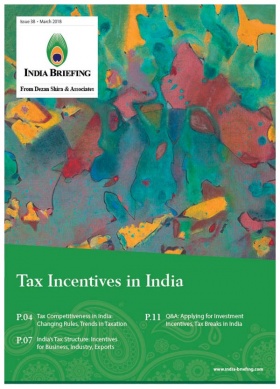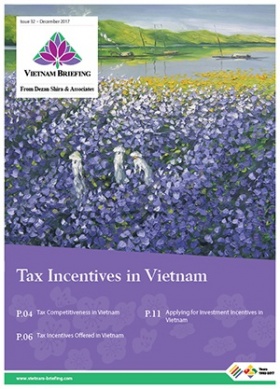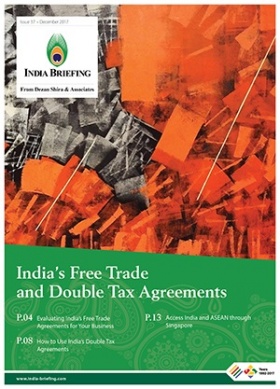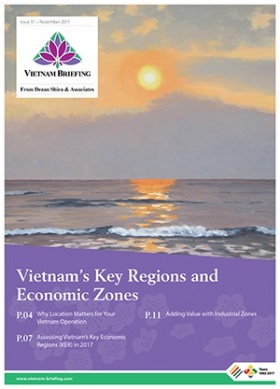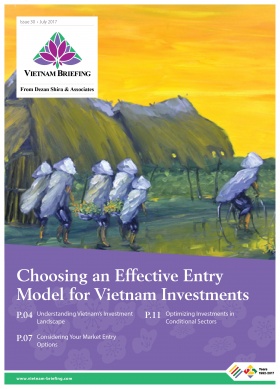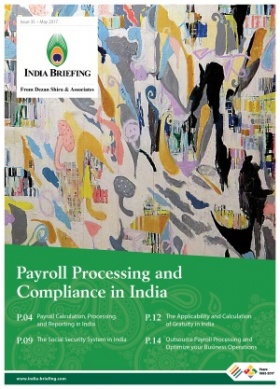India-Vietnam: A Comprehensive Strategic Partnership Emerges
South Asia is currently witnessing a rapid growth spurt, with a resurgence in investor interest despite the occasional geopolitical foible. India and Vietnam hold key positions in this region – on both trade and commerce as well as understanding on political and security issues.
As a member of the Association of Southeast Asian Nations (ASEAN), Vietnam is an important enabler for India’s growing trade and investment ties with the rest of Southeast Asia – the focus of India’s ‘Act East’ Policy.
In 2017, India and Vietnam celebrated 45 years since the two countries established diplomatic ties. To commemorate their growing partnership, Vietnamese President Tran Dai Quang visited India in early March this year.
During this official visit, Dai Quang discussed several areas of bilateral interest, including international security in maritime and cyberspace and strengthening regional trade engagement. A joint statement, issued after the visit points towards larger cooperation between the two countries in oil and gas exploration, manufacturing, and agricultural technology.
In this article, we offer a debrief on bilateral trade relations between India and Vietnam and examine the investment landscape for firms based in these countries.
Regional linkages improve
Vietnam appreciates the cultural and religious similarities between the two economies, which have helped promote the tourism industry in Vietnam.
To supplement this relationship, VietJet recently announced four direct weekly flights, starting July 2018 from New Delhi to Ho Chi Minh City.
Vietnam is slated to become the world’s third fastest growing market for international passengers and freight. While the aviation industry in Vietnam is still in its formative stages, the government is keen to promote investment and has liberalized rules for this sector. This could be an interesting prospect for Indian companies, such as the GMR group – India’s leading aviation infrastructure company.
Both Vietnam and India stress the importance of better regional connectivity for tourism and trade to prosper.
The two sides now propose to expedite talks on extending the India-Myanmar-Thailand Trilateral Highway up to Vietnam through Cambodia and Laos. Albeit in the discussion stage, players in the logistics and construction sectors should stay tuned to the region’s developments for investment opportunities.
India-Vietnam trade relations
The two nations signed an MoU in March for furthering economic and trade cooperation. India’s Council of Agricultural Research and Vietnam’s Ministry of Agriculture and Rural Development designed a comprehensive work plan for 2018-2020 to promote the transfer of technology and technical expertise in the field of agriculture and its allied sectors.
A Joint Sub-Commission on Trade meeting will take place this year in Vietnam’s capital city, Hanoi – where both countries will discuss reducing trade barriers in the implementation of the Framework Agreement on Comprehensive Economic Cooperation between ASEAN and India.
India and Vietnam have set a trade target of US$15 billion (Rs 97,778 crore) by 2020. Bilateral trade increased almost tenfold over the last 10 years, from US$1.15 billion (Rs 7,494 crore) in 2007 to US$10.1 billion (Rs 65,840 crore) in 2017. India is Vietnam’s fifth largest trading partner in ASEAN; Vietnam holds the 19th position worldwide for India.
Major Indian imports from Vietnam include: electrical and electronic equipment, rubber, machinery and instruments, coffee, tea, and spices. Major Vietnamese imports from India are: meat and edible meat offal, fish, crustaceans, iron and steel, cotton, corn and cereals, pods and seeds of peanuts, seeds of cassia, cocoa, beans, and tamarind.
Spotlight: The Tata Group in Vietnam
Tata International, the global arm for trading and distribution for the Tata Group, signed two MOU’s for its Vietnam operations in March. The first was with a leading Vietnamese company, the Vissai Cement Group, for a joint venture to utilize the Vinh Port for easier access to sea-trade routes and coal imports. The second was with Agribank, the largest commercial bank in Vietnam, for the financing of farm equipment.
Tata Power, the largest power company in India and a subsidiary of the Tata Group, is working towards setting up a US$2.2 billion 1,320-megawatt thermal power plant in the Soc Trang province, and has another thermal plant in the proposal stage.
India’s largest coffee producer and exporter, Tata Coffee, is also working on a US$63 million (Rs 410 crore) state of the art facility for freeze-dried coffee in Binh Duong province. The Tata Group also trades in steel and pesticides with Vietnam.
The Tata Group is among the largest Indian investors in Vietnam. The proposed projects will further trade and investment targets set by the two countries. Moreover, Tata’s success in the Vietnamese market will bolster Indian investor confidence towards Vietnam.
Accessing South Asian and ASEAN markets
Close cultural ties and similarities in the economic growth dynamics between India and Vietnam makes navigating these markets easier for investors based in either of the two nations.
Competitive labor costs, a large growing middle class, and the ease of setting up – are all major draws for investors looking at both Vietnam and India.
India’s ‘Make in India’ manufacturing program offers attractive incentives for Vietnamese businesses, and India is rapidly implementing ease of doing business reforms; meanwhile, connectivity between the South Asian and ASEAN region continues to expand.
Both governments urge businesspersons to take advantage of various opportunities in different priority sectors within the two economies, including hydrocarbons, power generation, renewable energy, energy conservation, infrastructure, textiles, footwear, pharmaceuticals, machine tools, agriculture and agro-products, tourism, chemicals, ICT, and other service sector industries.
India now has 131 major projects in Vietnam in the areas of food processing, fertilizers, auto components, and textile accessories, among others. Total Indian investments in Vietnam amounts to about US$1 billion (Rs 6,519 crore), ranking it 25th for FDI inflow to Vietnam.
Vietnam, on the other hand, has ample scope for improving its investments into India. It currently ranks 97th in terms of FDI inflow to India, at US$4.76 million (Rs 31.7 crore). Nevertheless, this is progress from investments worth US$0.12 million (Rs 78 lakh) in 2007.
Yet, with the business environment picking up in both countries and the opening up of regional borders, expectations point to a gain in investment momentum by 2020.
Saponti Baroowa, Associate Director, Business Intelligence at Dezan Shira & Associates‘ Vietnam office points to Vietnam’s Special Economic Zones as key investment destinations for Indian stakeholders in the region, though he feels that trade may remain the driving force in bilateral economic ties, in the near term.
Baroowa says, “Vietnam’s SEZs are a great opportunity for foreign investors to take advantage of preferential tax schemes while setting up operations in the country. However, barring a few Indian conglomerates that have invested in large projects in Vietnam, export-import trade is likely to remain the main driver of this relationship for the foreseeable future. This to a large extent will be driven by India’s own push towards export-oriented domestic manufacturing, which in turn might open up opportunities for increased sourcing of inputs from Vietnam.”
At the same time, Baroowa advises that Indian companies should take advantage of the improved market access: “Setting up manufacturing operations and supporting industries in Vietnam can tap into the country’s increasing demand for capital goods. Opportunities also exist for joint R&D and strategic partnerships with Vietnamese companies in rubber, marine products and leather industries. By setting up in Vietnam, Indian companies can integrate into the regional ASEAN supply chains as well as access opportunities further afield, in the light of Vietnam’s recent FTAs with the European Union and the Eurasian Economic Union”.
Koushan Das, Associate, Business Intelligence, at Dezan Shira & Associates, explains the merger and acquisition (M&A) method that India-based firms can adopt as a market entry strategy for Vietnam.
He says, “In 2017, the total foreign capital invested in Vietnam via M&As was about US$10.16 billion, driven by an increasing number of disinvestments in state owned enterprises (SOEs) in the food and beverage, logistics, and FMCG sectors. More disinvestments are planned for 2018 in the steel, textiles, transportation, construction, pharmaceuticals, and IT industries. This offers a multitude of opportunities for firms based in India and looking to acquire brands that are well known locally and have a majority market share.”
About Us
India Briefing is published by Asia Briefing, a subsidiary of Dezan Shira & Associates. We produce material for foreign investors throughout Eurasia, including ASEAN, China, Indonesia, Russia, the Silk Road, & Vietnam. For editorial matters please contact us here and for a complimentary subscription to our products, please click here.
Dezan Shira & Associates provide business intelligence, due diligence, legal, tax and advisory services throughout India and the Asian region. We maintain offices in Delhi and Mumbai and throughout China, South-East Asia, India, and Russia. For assistance with India investment issues or into Asia overall, please contact us at india@dezshira.com or visit us at www.dezshira.com.
- Previous Article Sin efectivo en India, ¿qué es el Aadhaar Pay?
- Next Article Swedish Investments in India: Business Reforms, Make in India Improve Long-Standing Ties




